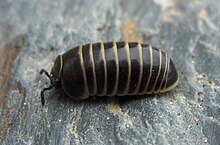Glomeris marginata
| Glomeris marginata | |
|---|---|
 |
|
| Scientific classification | |
| Kingdom: | Animalia |
| Phylum: | Arthropoda |
| Subphylum: | Myriapoda |
| Class: | Diplopoda |
| Order: | Glomerida |
| Family: | Glomeridae |
| Genus: | Glomeris |
| Species: | G. marginata |
| Binomial name | |
|
Glomeris marginata (Villers, 1789) |
|
| Synonyms | |
|
Oniscus marginata Villers, 1789 |
|
| External identifiers for Glomeris marginata | |
|---|---|
| Encyclopedia of Life | 1058621 |
| NCBI | 62006 |
Oniscus marginata Villers, 1789
Glomeris marginata is a common European species of pill millipede. It is a short millipede, rounded in cross-section, which is capable of rolling itself up into a ball when disturbed. This behaviour is also found in the pill woodlouse Armadillidium, with which G. marginata is often confused.
Glomeris marginata is found throughout central and north-western Europe, from Poland and Scandinavia to Spain and Italy. In the British Isles, it is found in all areas south of the Central Belt of Scotland.
Glomeris marginata grows up to 20 millimetres (0.8 in) long and 8 mm (0.3 in) wide, and is covered by twelve black dorsal plates with white rims. Each segment except those at the front and back bears two pairs of legs, with around 18 pairs in total. This distinguishes pill millipedes from pill woodlice, both of which are called "pillbugs" — woodlice have 7 pairs of walking legs, one per body segment, while millipedes have more pairs, and with two pairs to each apparent body segment.
When rolled into a ball, G. marginata can be distinguished from a rolled–up pill woodlouse by the asymmetrical ball it rolls into; pill woodlice roll into much more perfect spheres. The cuticle is also darker and shinier, and the antennae are shorter. The head and tail of a woodlouse have a greater number of small plates, while the head of Glomeris is protected by a single large shield, and it lacks the uropods of woodlice at the read end. Although usually black, red, yellow and brown individuals do occasionally occur.
Glomeris marginata lives in leaf litter as well as in grass and under stones, with a preference for calcareous soils. In domestic gardens, they are most frequent along hedgerows and at the bases of old walls, where the mortar has started to crumble, leaching lime into the soil. It is less prone to desiccation than other millipedes and can be found in the open, even in sunny weather, although they are more active at night and prefer more humid areas.G. marginata feeds on old, rotting leaves, despite the higher nutrient content of freshly–fallen leaves, and G. marginata can be responsible for recycling a significant proportion of the nutrients in the leaf litter.
...
Wikipedia
